Tag: life processes class 10 full notes
Life Process Notes Class 10 NCERT Science Chapter 5
Life Process Notes Class 10: All living organisms share fundamental characteristics that set them apart from non-living entities. These traits include breathing, growth, the need for nutrition, reproduction, and responsiveness to stimuli. These collective attributes distinguish living beings from the inanimate world.
To maintain a stable internal environment and ensure proper functioning, living organisms undergo vital processes known as life processes. These essential activities persist even during periods of rest or inactivity. Life processes, which encompass nutrition, photosynthesis (for plants), transportation, metabolism, respiration, reproduction, and excretion, are indispensable for all living organisms, spanning both the plant and animal kingdoms.
Throughout the Life Process Notes Class 10, we will delve into the intricacies of these life processes, with a particular focus on how they manifest in plants, animals, and human beings.
Life Process Notes Class 10 NCERT Science Chapter 5
What is Life?
As far as our current knowledge extends, Earth stands as the sole known planet to harbor life. Within this remarkable biosphere, beings are born, live, pass away, and eventually integrate back into nature.
The distinction between living organisms and inanimate entities is discernible through a range of criteria, primarily rooted in the various life processes they undergo.
Life Process
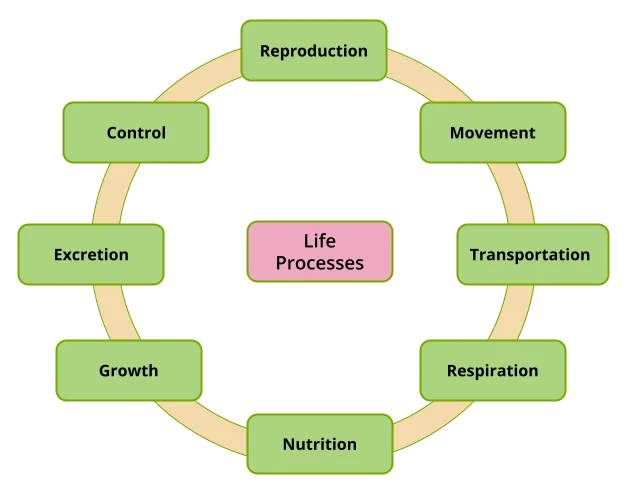
Life Process Notes Class 10 – Image 1
The sustenance of living organisms remains crucial irrespective of whether they are in motion, at rest, or even asleep. The combined processes responsible for maintaining life are known as life processes. Nutrition, respiration, circulation, and excretion are among the fundamental life processes that play a vital role.
In unicellular organisms, a single cell is responsible for performing all these essential processes. On the other hand, multicellular organisms possess well-developed systems specifically designed to carry out these crucial life processes efficiently.
Nutrition: Life Process Notes Class 10
Nutrition refers to the process by which an organism obtains the essential nutrients required for nourishment and sustenance. There are two primary modes of nutrition: autotrophic and heterotrophic.
Autotrophic nutrition is found in plants, algae, and certain bacteria. These organisms synthesize their own food using light energy (photosynthesis) or chemical energy (chemosynthesis).
Heterotrophic nutrition is observed in bacteria, fungi, and animals. They acquire energy from organic compounds by consuming plants or other animals as food.
Heterotrophic nutrition further encompasses subtypes such as holozoic (ingesting solid food), saprophytic (feeding on decaying matter), and parasitic (feeding on a host organism).
Autotrophic Nutrition
When an organism can sustain itself by producing its own food using sunlight or chemicals, this mode of nutrition is referred to as autotrophic nutrition.
Plants exemplify photoautotrophs as they photosynthesize, harnessing light energy to synthesize their food.
On the other hand, some bacteria are chemoautotrophs, utilizing chemical substances to obtain energy for their nourishment.
Photosynthesis
Photosynthesis plays a crucial role in the formation of food. Plants utilize sunlight and water to create nourishment not only for themselves but also for other organisms.
Within the green parts of plants, chlorophyll absorbs light energy. This energy is employed to split water into hydrogen and oxygen. Subsequently, the hydrogen is utilized to reduce carbon dioxide, converting it into carbohydrates, primarily glucose.
Chlorophyll serves as a vital component of photosynthesis, while stomata facilitate the intake of carbon dioxide from the surroundings.
The overall chemical reaction for photosynthesis can be represented as follows:
6CO2 + 6H2O → C6H12O6 + 6O2
Stomata
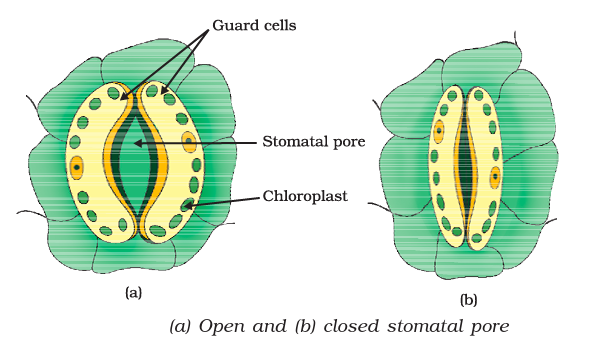
Life Process Notes Class 10 – Image 2
Stomata are small pores present on the leaves that play a vital role in gas exchange.
Primarily located on the underside of the leaf, these pores allow the entry and exit of gases.
Each stoma is flanked by guard cells, responsible for regulating the opening and closing of the pore.
The functioning of the guard cells is influenced by their water content, determining the extent of gas exchange through the stomata.
Saprophytic Nutrition
Saprophytic nutrition refers to the mode of nutrition in which certain organisms feed on dead and decaying organic matter.
Parasitic Nutrition
The parasitic mode of nutrition involves certain organisms feeding at the expense of another organism, causing harm in the process.
These parasites thrive either on or inside the body of a host organism, obtaining their nutrients directly from the host’s body.
For instance, leeches are examples of ectoparasites, while Ascaris represents an endoparasite. Additionally, there are parasitic plants like Cuscuta that exhibit this mode of nutrition.
Nutrition in Amoeba
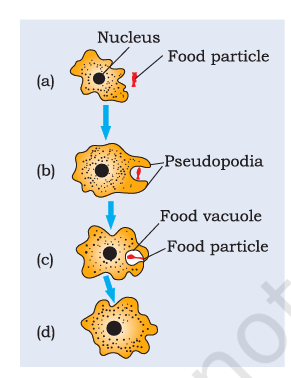
Life Process Notes Class 10 – Image 3
Amoeba adopts the Holozoic mode of nutrition for feeding. Using pseudopodia, it engulfs food particles through a process called phagocytosis. The engulfed food becomes enclosed within a food vacuole.
As the food vacuole moves through the cytoplasm, digestion, absorption, and assimilation occur.
Once the food vacuole opens outside, the undigested food is expelled through egestion.
Nutrition in Paramoecium
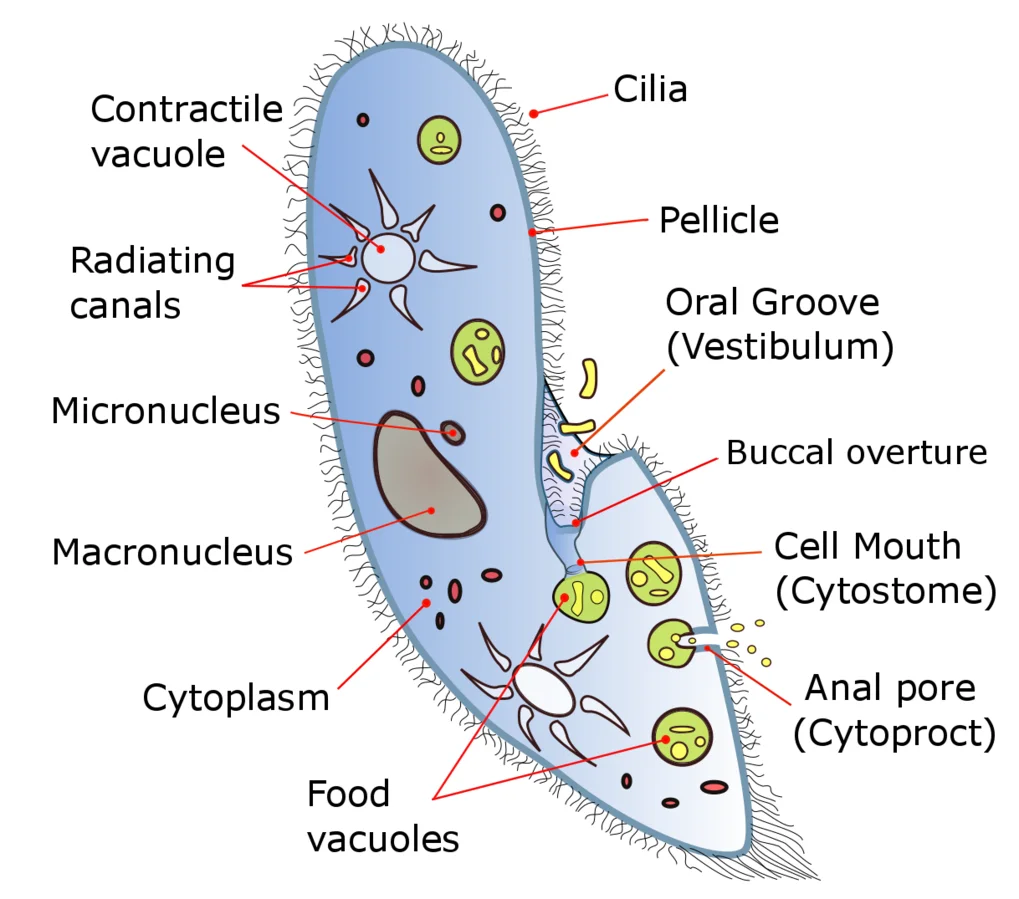
Life Process Notes Class 10 – Image 4
- Paramoecium, like Amoeba, demonstrates holozoic nutrition.
- The presence of cilia aids Paramoecium in engulfing food through the oral groove.
- Upon engulfment, a food vacuole forms, enclosing the ingested food.
- The food vacuole undergoes movement through the cytoplasm in a process known as cyclosis.
- Within the food vacuole, digestion occurs, and the nutrients are absorbed by the cytoplasm.
- Any undigested food is eliminated through a small pore called an anal pore or cytopyge.
Nutrition in Humans: Life Process Notes Class 10
- Humans are classified as omnivores, capable of consuming both plant-based and animal-based foods.
- Due to their higher complexity, humans possess a sophisticated nutrition system.
- The digestive system comprises an alimentary canal and associated digestive glands, working in unison to provide nourishment to the body.
- Human nutrition consists of five stages: Ingestion, Digestion, Absorption, Assimilation, and Egestion.
- Among these stages, ingestion, digestion, absorption, and egestion occur within the alimentary canal, while assimilation takes place throughout the entire body.
Alimentary Canal
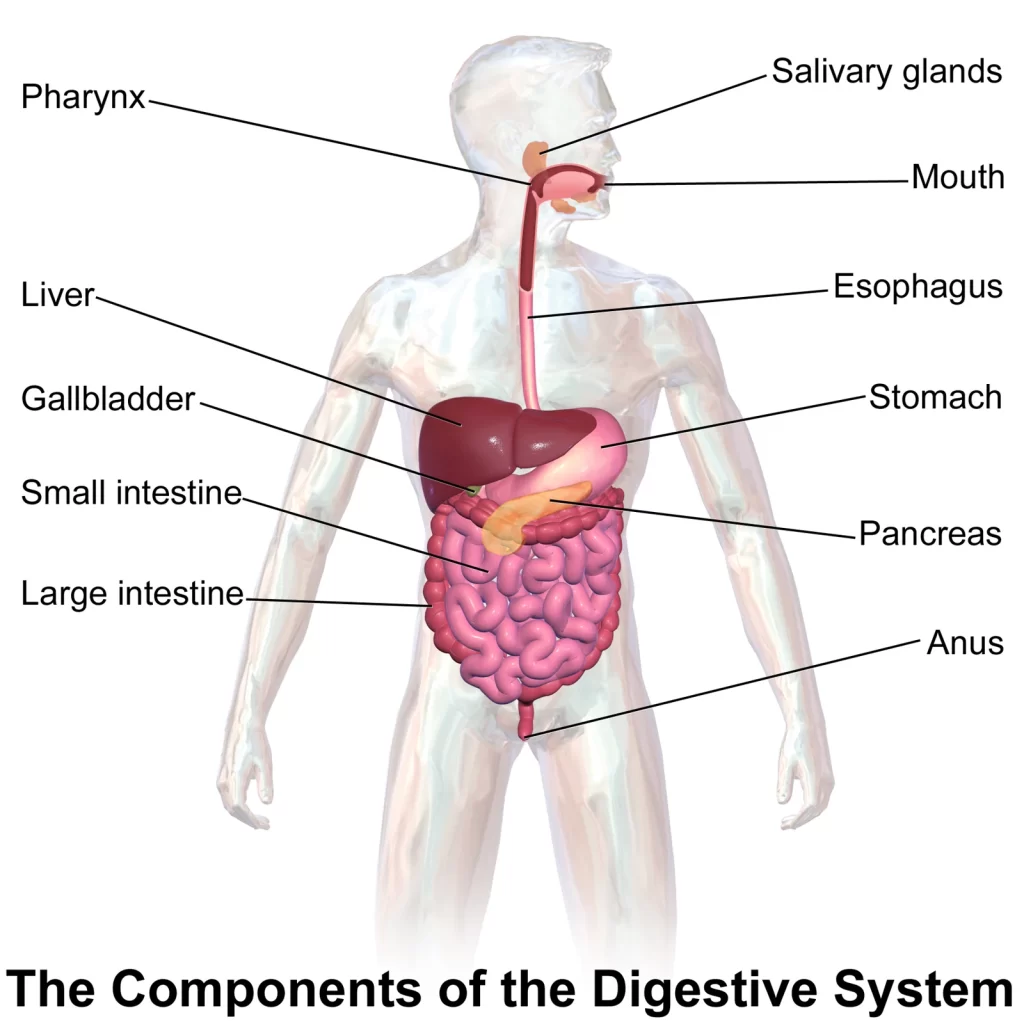
Life Process Notes Class 10 – Image 5
- The human alimentary canal is an elongated tube with varying diameters.
- It begins at the mouth and extends to the anus.
- The parts of the alimentary canal consist of the esophagus, stomach, small intestine, and large intestine.
Mouth
- The mouth serves as the entrance to the alimentary canal, facilitating the ingestion of food.
- Located behind the mouth, the buccal cavity is often referred to as the mouth itself.
- Inside the buccal cavity, teeth aid in the mastication or chewing of food.
- The tongue, equipped with taste buds, contributes to the sensation of taste while eating.
- Additionally, salivary glands open into the buccal cavity, releasing saliva that initiates the process of digestion.
Teeth

Life Process Notes Class 10 – Image 6
- Teeth are rigid structures found in the buccal cavity, serving to cut, shear, and masticate the food we consume.
- A vertical section of a tooth reveals four distinct layers: enamel, dentine, cement, and dental pulp.
- Enamel, the outermost layer, showcases a glossy appearance, high mineral content, and stands as the hardest substance in the human body.
- Dentine forms the bulk of the tooth and comprises approximately 70% inorganic salts.
Cement lines the tooth and the bony socket it rests in. - The dental pulp, residing at the tooth’s core, contains nerve endings, blood vessels, lymph vessels, and connective tissue.
- Humans possess four types of teeth: incisors, canines, molars, and premolars, each fulfilling specific functions.
- Incisors are adept at cutting food, canines excel at tearing it apart, while molars and premolars skillfully crush and grind it.
- In adult humans, the dental formula represents the number of each type of tooth on one-half of the mouth, and it is expressed as 2:1:2:3.
Life Process Notes Class 10
Oesophagus
- Once swallowed, the food proceeds into the esophagus, a muscular tube approximately 25 cm in length, equipped with a sphincter (valve or opening) at each end.
- The primary role of the esophagus is to facilitate the movement of food and fluids, from the mouth to the stomach, after they have been swallowed.
- Peristaltic movements within the esophagus push the food downward, aiding in its smooth transportation.
Stomach
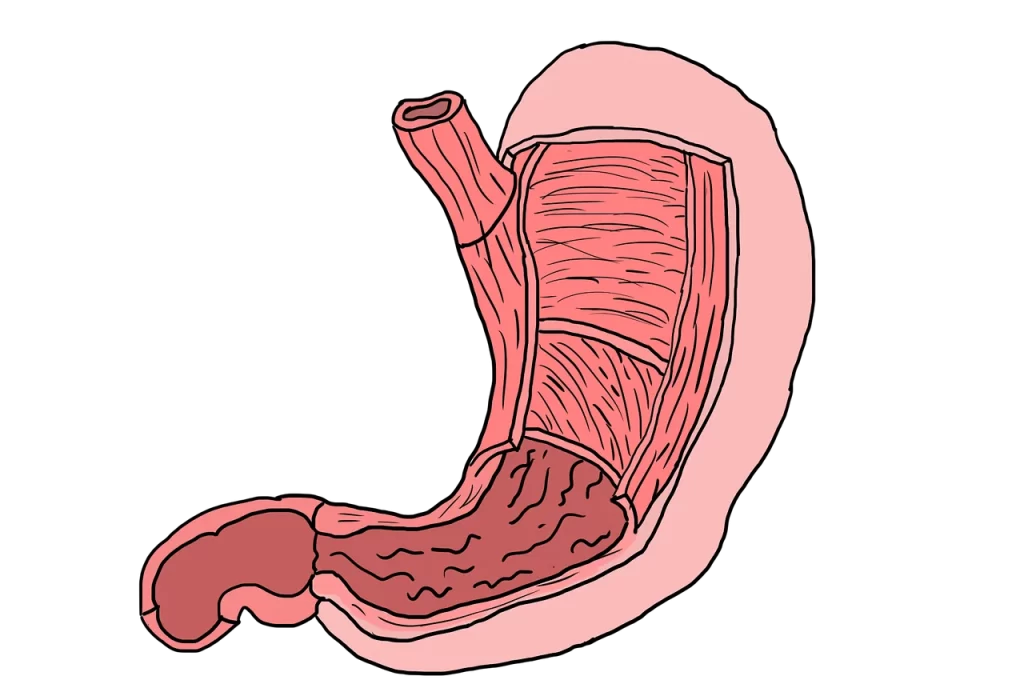
- The stomach is a robust, sack-shaped organ, receiving food from the esophagus at one end and connecting to the small intestine at the other end.
- The inner lining of the stomach produces mucous, hydrochloric acid, and digestive juices.
- Within the stomach, food is mixed and churned, forming a semi-solid mass called chyme.
- Enzymes present in gastric juice actively break down the food particles.
- Hydrochloric acid serves two purposes: aiding in the partial digestion of proteins and neutralizing harmful bacteria.
- To protect its own wall from the action of hydrochloric acid, the stomach secretes a protective layer of mucus.
Small Intestine
- The small intestine, the lengthiest segment of the alimentary canal, measures approximately 20 feet in humans.
- It comprises distinct regions: the duodenum, which follows the stomach; the jejunum, located in the middle part; and the ileum, which extends further into the large intestine.
- The internal lining of the small intestine is structured into finger-like projections known as villi.
- In the duodenum, a common pancreatic duct from both the pancreas and liver opens.
- The majority of chemical digestion and absorption of nutrients occur within the small intestine.
Large Intestine
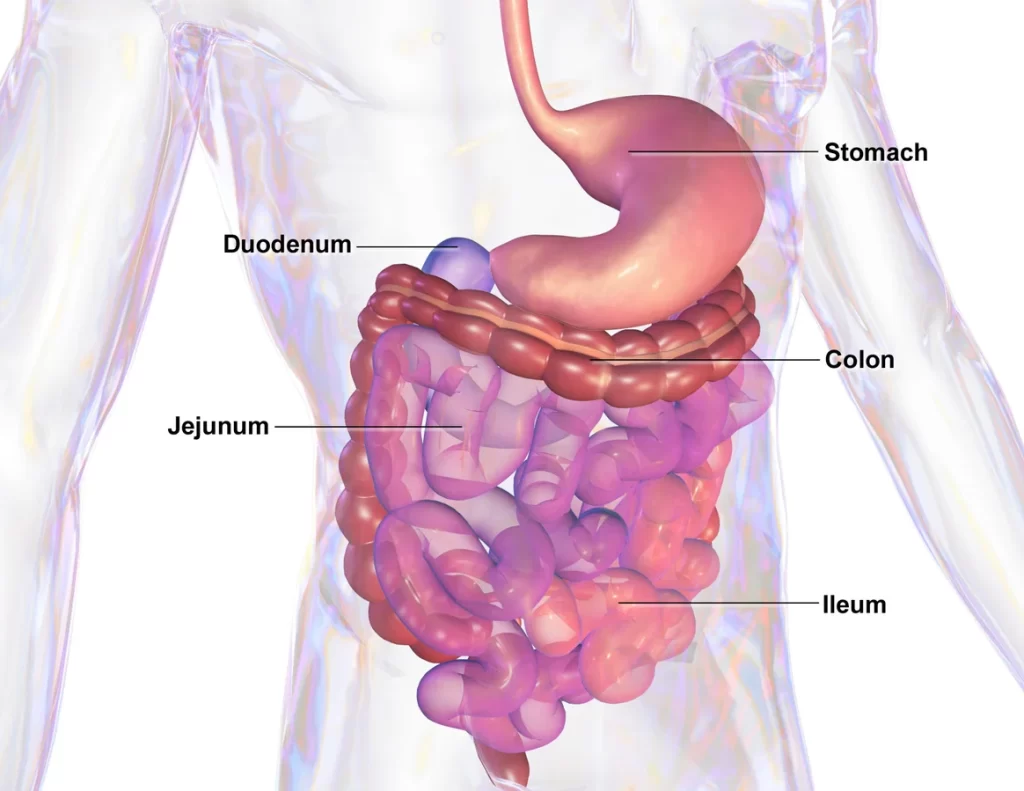
- The human large intestine spans approximately 5 feet in length.
- It consists of two main regions: the colon, which is about 1.5 meters long, and the rectum, measuring around 10 centimeters in adults.
- Following the ileum, the large intestine continues as the colon, which can be further divided into three segments: the ascending colon, transverse colon, and descending colon.
- At the base of the ascending colon, a small finger-like projection called the appendix can be observed. This structure houses beneficial bacteria necessary for food digestion.
- The rectum serves as the terminal part of the large intestine and opens externally through the anus.
- Within the anus, there are internal and external anal sphincters, responsible for controlling bowel movements.
Peristalsis
Peristalsis refers to a continuous, wave-like motion that occurs throughout the alimentary canal, starting from the esophagus and extending to the small intestine.
The muscles found in the alimentary canal’s wall are responsible for generating peristalsis.
This coordinated movement aids in propelling food along the entire length of the alimentary canal.
Digestive Glands
- Numerous glands contribute digestive juices essential for food digestion.
- Among them are the salivary glands, gastric glands, liver, gallbladder, and pancreas.
- The salivary glands produce saliva, which initiates the digestion process in the mouth.
- Gastric glands, located in the stomach wall, secrete hydrochloric acid and the enzyme pepsin.
- The liver secretes bile, stored in the gallbladder, to aid in the digestion of fats.
- The pancreas releases a variety of digestive enzymes, collectively known as pancreatic juice.
- Pancreatic juice contains enzymes such as trypsin, chymotrypsin, lipase, and amylase, crucial for effective food digestion.
Pancreas
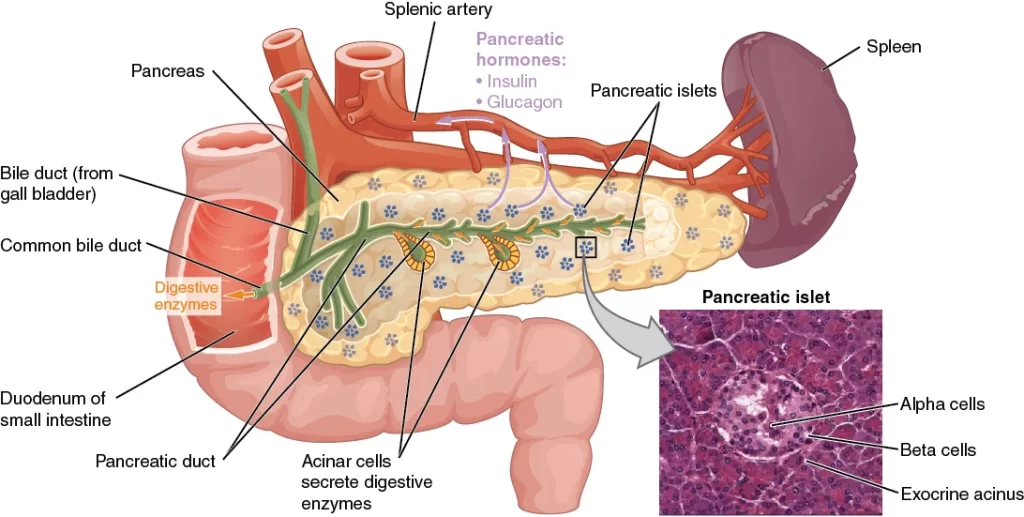
- The pancreas, located behind the stomach in humans, is a lengthy and flat gland.
- This gland plays a significant role as both an endocrine and exocrine organ.
- In its capacity as an endocrine organ, the pancreas releases two hormones, insulin and glucagon, which regulate blood sugar levels.
- As an exocrine gland, the pancreas secretes pancreatic juice, consisting of a combination of various digestive enzymes.
- These digestive enzymes include trypsin and chymotrypsin, which are proteases responsible for breaking down proteins.
- Additionally, the pancreas secretes amylase, which aids in digesting the starch content of food.
- Another essential component of pancreatic enzymes is pancreatic lipases, vital for the digestion of fats.
Holozoic Nutrition
Holozoic nutrition refers to the mode of nutrition in which animals consume their food in its entirety.
In holozoic nutrition, the process involves five distinct steps: ingestion, digestion, absorption, assimilation, and egestion.
Physiology of Digestion
- Mechanical digestion initiates in the buccal cavity, where teeth chew and grind the food, while saliva mixes with it, forming a bolus.
- The digestion of starch commences in the buccal cavity, facilitated by salivary amylase, which converts starch into maltose.
- In the stomach, food is churned through the muscular contraction and relaxation of its wall, breaking it down into simpler substances.
- The digestion of proteins begins in the stomach with the action of pepsin, which breaks proteins into smaller fragments known as peptides.
- The bolus, after mixing with gastric juice, transforms into a fine, soluble form called chyme.
- Upon entering the small intestine, complete digestion occurs, facilitated by various enzymes present in the pancreatic juice, bile, and intestinal juice.
- The digested food is thoroughly absorbed by the villi and microvilli of the small intestine.
- Subsequently, undigested food enters the large intestine.
- In the large intestine, the colon facilitates the absorption of water and salts, while the rectum temporarily stores the undigested food before defecation.
Digestive System in Other Animals
- The structure and function of digestive systems differ across various animal species.
- The design of the digestive system is influenced by the animal’s food habits.
- Herbivores have a lengthy alimentary canal since their plant-based diet contains cellulose, which takes a considerable time to digest.
- Conversely, carnivorous animals possess a relatively shorter alimentary canal as meat is digested more rapidly.
Anatomy of Digestive Tract
- The human alimentary canal, also known as the gastrointestinal tract, stretches approximately 30 feet (9 meters) in length.
- Starting from the mouth, it extends all the way to the anus, serving as a tube with varying diameters.
- The alimentary canal includes several distinct parts: the esophagus, stomach, and small intestine (comprising the duodenum, jejunum, and ileum), as well as the large intestine (consisting of the colon and rectum).
- For the digestion process, salivary glands, pancreas, and liver play vital roles as major digestive glands.
- Additionally, glands present in the walls of the stomach and small intestine also contribute significantly to the digestion of food.
Role of HCl
- The gastric glands present in the stomach wall are responsible for secreting hydrochloric acid.
- The pH of gastric acid typically ranges between 1.5 to 3.5.
- The hydrochloric acid fulfills several important functions:
- It converts inactive pepsinogen and pro-rennin into their active forms, pepsin and rennin, respectively.
- The acidic environment created by the gastric acid facilitates the digestion of proteins.
- It acts as a defense mechanism by killing bacteria that may have entered the body through food, preventing infections.
- By creating an acidic environment, it hinders the putrefaction of food in the stomach.
- To protect itself from the corrosive action of gastric acid, the stomach secretes a thick layer of mucus through its mucous glands.
- Excessive amounts of acid can lead to damage to the gastric mucosa and result in gastric and duodenal ulcers.
Salivary Glands
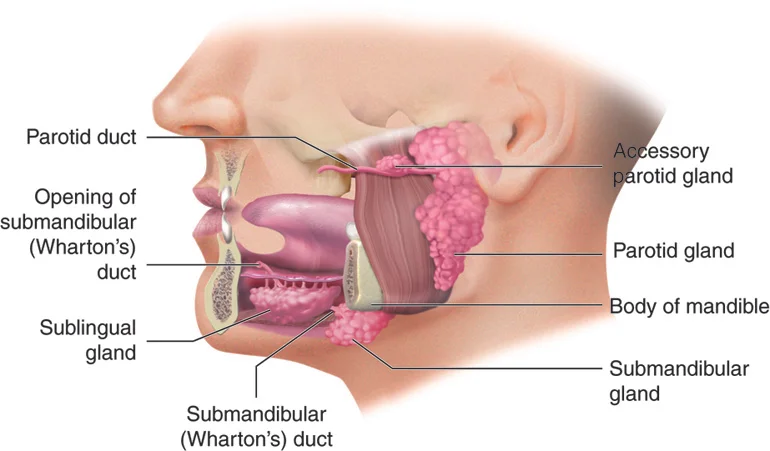
- Salivary glands, as exocrine glands, secrete saliva, which is then delivered to the mouth through a system of ducts.
- In humans, there are three major pairs of salivary glands: parotid, submandibular, and sublingual.
- Typically, healthy individuals produce around 0.5 to 1.5 liters of saliva per day.
- Saliva serves multiple important functions in the oral cavity:
- It lubricates and safeguards the soft and hard tissues of the oral cavity.
- Saliva provides protection against dental caries.
- It inhibits microbial growth in the oral cavity.
- Saliva promotes soft tissue repair by reducing clotting time and increasing wound contraction.
- Containing the enzyme amylase, saliva initiates the hydrolysis of starch into maltose and dextrin, enabling digestion to begin before food reaches the stomach.
- Saliva acts as a solvent, allowing solid particles to dissolve and interact with the taste buds on the tongue.
Heterotrophic Nutrition
- Heterotrophic mode of nutrition refers to a nutritional strategy in which an organism relies on others for food.
- These organisms depend on autotrophs to fulfill their nutritional needs.
- For instance, animals that consume plants as their food are known as herbivores, while those that feed on other animals are called carnivores.
- Holozoic, saprophytic, and parasitic nutrition are all different types of heterotrophic nutrition.
Glandular Epithelium
- Numerous small glands play a vital role in the digestion of food, primarily located within the inner layer of the stomach and intestine.
- These glands are situated in the epithelial lining of both the stomach and intestine.
- The glands found in different regions of the stomach are known as gastric glands. Their responsibilities include the secretion of mucus, hydrochloric acid, and enzymes like pepsinogen.
- Within the epithelial lining of the small intestine and large intestine, we find the intestinal glands.
- The glands in the small intestine secrete intestinal juice, also referred to as succus entericus. This juice contains hormones, digestive enzymes, alkaline mucus, and substances that neutralize hydrochloric acid coming from the stomach.
- Intestinal juice effectively completes the digestion initiated by pancreatic juice.
- As for the glands in the large intestine, their function involves facilitating the absorption of water and electrolytes.
Villi and Micro Villi
- The small intestine is responsible for the complete digestion and absorption of food.
- The digestion process is completed with the help of pancreatic juice from the pancreas, bile from the liver, and intestinal juice secreted by the intestinal glands.
- To absorb all the digested nutrients efficiently, the small intestine is lined with long finger-like projections known as villi (singular: villus).
- Each villus has its cell membrane on the lumen side, which is further folded into microscopic processes called microvilli, significantly increasing the internal surface area of the intestinal walls for absorption.
- Digested nutrients pass through diffusion into the semipermeable villi.
- Moreover, villi actively participate in the chemical digestion of food by secreting digestive enzymes.
Liver
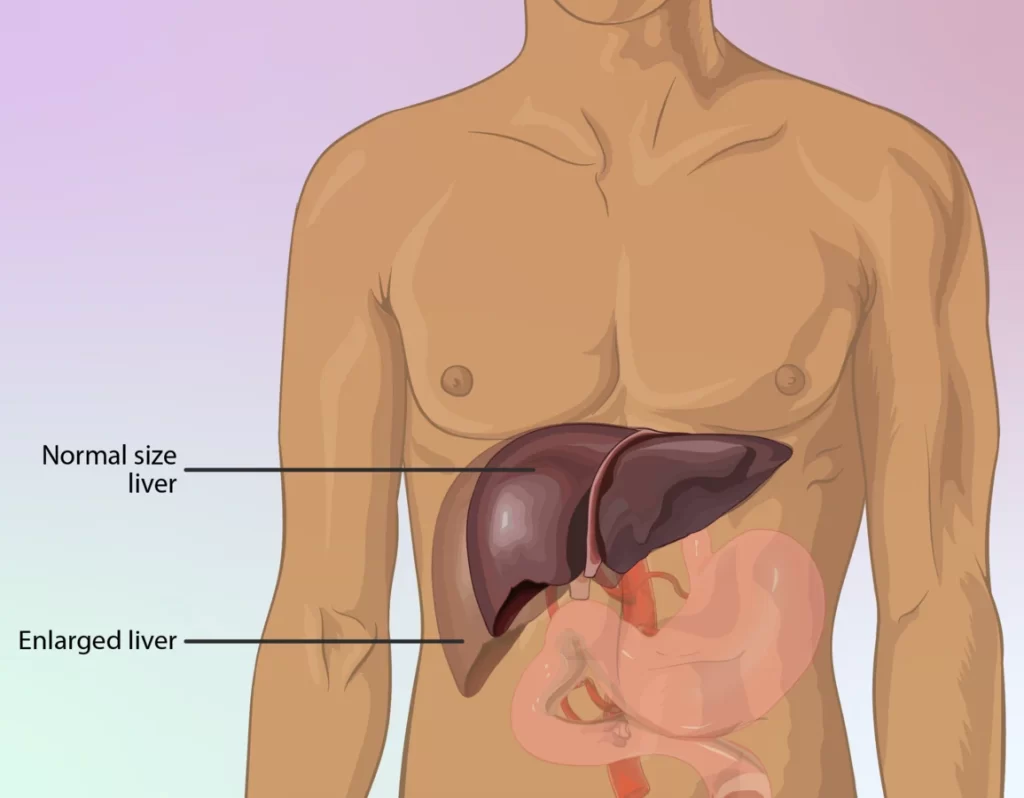
- The liver serves as the largest and principal digestive gland in humans.
- Positioned in the upper right-hand portion of the abdomen, this organ exhibits a dark reddish-brown color due to its rich blood supply.
- The liver fulfills several significant functions, including:
- Secreting bile, which aids in the digestion process.
- Filtering the blood from the digestive tract before distributing it to the rest of the body.
- Detoxifying various metabolites and acting as an antidote.
- Producing essential proteins for blood clotting and other bodily functions.
- Storing and releasing glucose as required.
- Processing hemoglobin from dead and worn-out red blood cells, specifically for storing iron.
- Facilitating the conversion of harmful ammonia into urea, a less toxic substance, in the liver.
Digestive Juices
- Collectively known as digestive juices, pancreatic juice, bile, and intestinal juice (succus entericus) play essential roles in the digestion process.
- A common duct connects the digestive glands and pours their secretions into the duodenum.
- Upon entering the small intestine, chyme undergoes complete digestion, facilitated by various enzymes.
- In the duodenum, the acidity of chyme is converted to alkalinity by the action of bile from the liver, which is crucial for the activity of pancreatic enzymes.
- Bile also emulsifies fats into smaller globules, aiding in their digestion.
- Pancreatic and intestinal amylases work together to break down carbohydrates into glucose.
- For the breakdown of proteins into amino acids, trypsin and chymotrypsin serve as the proteases responsible.
- Finally, lipase, an essential enzyme, acts on the emulsified fats, breaking them down into glycerol and fatty acids.
Water Absorption in Large Intestine
- The large intestine does not partake in the digestion of food or the absorption of nutrients.
- Its primary role revolves around absorbing water from the remaining indigestible food material, thereby solidifying the stool.
- Additionally, the large intestine aids in the absorption of vitamins produced by bacteria that inhabit this region.
- Moreover, the innermost layer of the large intestine acts as a protective barrier, safeguarding against microbial infections and invasions.
- The rectum temporarily stores undigested food until it is eventually expelled during the process of defecation.
Respiration
Introduction to Respiration
- Respiration broadly means the exchange of gases.
- Animals and plants have different means of exchange of gases.
- At a cellular level, respiration means the burning of food to generate the energy needed for other life processes.
- Cellular respiration may take place in the presence or absence of oxygen.
Respiration in Humans
- The human respiratory system is a sophisticated system responsible for vital processes such as breathing, gas exchange, and cellular respiration.
- A well-organized respiratory system facilitates the smooth process of breathing and gas exchange.
- Breathing involves the inhalation of oxygen and the exhalation of carbon dioxide, a crucial exchange that sustains life.
- This gaseous exchange occurs within the lungs, ensuring that oxygen is distributed to all cells throughout the body.
- Cellular respiration, a fundamental process, takes place in every cell, providing the energy needed for various cellular activities.
Respiratory System
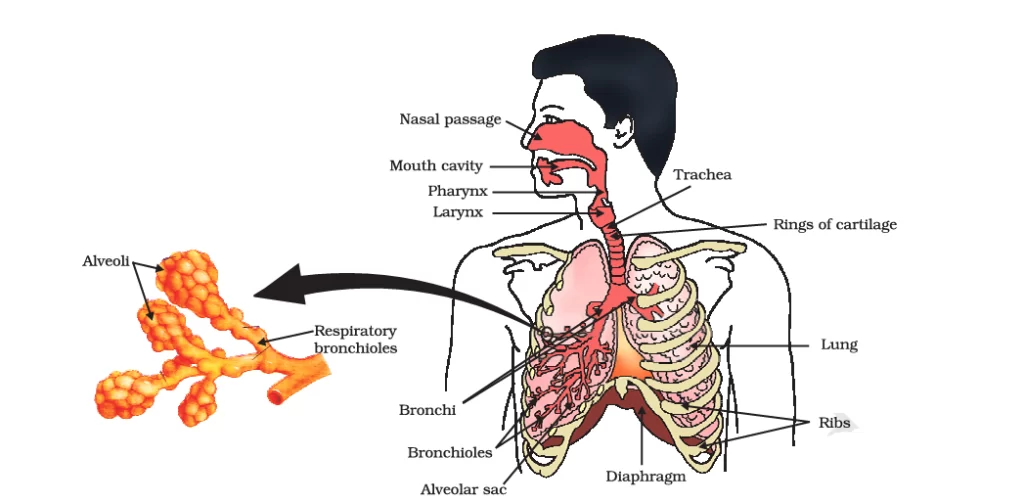
- The human respiratory system comprises various essential components, including the nose, nasal cavities, pharynx, larynx, trachea (windpipe), bronchi, bronchioles, and alveoli.
- A pair of lungs encloses the bronchioles and alveoli.
- To facilitate the inhalation and exhalation of gases, the rib cage, muscles associated with it, and the diaphragm all play vital roles.
- The exchange of gases transpires between the alveolar surface and the surrounding blood vessels.
- Alveoli, with their extensive surface area, serve as crucial sites for the efficient exchange of gases.
Physiology of Respiration
- Breathing in humans is facilitated by the coordinated action of internal intercostal and external intercostal muscles, which attach to the ribs, and the diaphragm.
- During inhalation, the dome-shaped diaphragm contracts, flattening out, and the rib cage expands due to the intercostal muscles’ action. This process increases the lungs’ volume, causing a drop in pressure, and allows air to rush in from the outside.
- To exhale, the diaphragm relaxes and returns to its dome shape, while the chest cavity contracts due to the intercostal muscles’ action. This reduces the volume inside the lungs, increases pressure, and forces air out.
- Inhaled air enriches the oxygen concentration in the alveoli, allowing oxygen to simply diffuse into the surrounding blood vessels.
- Conversely, blood coming from cells carries a higher concentration of carbon dioxide than the outside air, leading carbon dioxide to diffuse out of the blood vessels into the alveoli.
- Therefore, breathing occurs due to the combined action of intercostal muscles and the diaphragm, while the exchange of gases takes place through the simple process of diffusion.
Inhalation and Exhalation
- Inhalation refers to the process of taking in air rich in oxygen, while exhalation involves giving out air rich in carbon dioxide.
- A single breath encompasses both inhalation and exhalation.
- Throughout the day, a person breathes numerous times.
- The frequency of breathing, measured as the number of breaths in one minute, is known as the individual’s breathing rate.
Diffusion
Diffusion is the natural movement of molecules from areas of high concentration to areas of low concentration, occurring spontaneously without the expenditure of any energy.
Cellular Respiration
Cellular respiration is a series of metabolic reactions that occur within cells, converting the biochemical energy obtained from food into a chemical compound known as adenosine triphosphate (ATP).
Metabolism encompasses a range of chemical reactions carried out to sustain the cells’ living state in an organism. These reactions can be categorized into two groups:
1. Catabolism: This involves breaking down larger molecules to release energy.
2. Anabolism: It pertains to the synthesis of various compounds required by the cells.
Respiration is classified as a catabolic process as it breaks down large molecules into smaller ones, releasing energy to fuel cellular activities.
The key processes of cellular respiration include glycolysis, the Krebs cycle, and the electron transport chain.
Aerobic Respiration
Aerobic respiration is a metabolic process that converts glucose, a type of food, into energy in the presence of oxygen.
The overall equation for aerobic respiration is as follows:
Glucose + Oxygen ⇒ Carbon Dioxide + Water + Energy
This vital process occurs in animals, plants, and other living organisms.
Respiration in Lower Animals
- Lower animals do not possess a complex respiratory system like lungs and alveoli. Instead, their respiration occurs through simple exchange mechanisms.
- For instance, animals like earthworms take in gases directly through their skin.
- Fishes have gills that facilitate gaseous exchange in water.
- Insects utilize a tracheal system, which comprises a network of tubes that enable air circulation and gaseous exchange.
- As for frogs, they breathe through their skin while in water and use their lungs for respiration when on land.
Respiration in Muscles
- Muscle respiration can become anaerobic when there is an insufficient supply of oxygen.
- Under such conditions, glucose undergoes breakdown, resulting in the production of carbon dioxide and lactic acid.
- The accumulation of lactic acid leads to muscle soreness.
- This specific form of anaerobic respiration is referred to as lactic acid fermentation.
ATP
- ATP serves as the cell’s energy currency.
- ATP is an abbreviation for Adenosine Tri-Phosphate.
- This molecule is formed as a result of crucial reactions like photosynthesis and respiration.
- The three phosphate bonds in ATP are high-energy bonds, and their breaking releases a significant amount of energy.
- This released energy is subsequently utilized for various other metabolic reactions.
Respiration in Plants
- Plants lack specialized structures for gaseous exchange, unlike animals and humans.
- Instead, they rely on stomata (located in leaves) and lenticels (found in stems) to facilitate gas exchange.
- In comparison to animals, the rate of respiration in plant roots, stems, and leaves is significantly lower.
Transpiration
- Transpiration is a natural biological process whereby water is released in the form of water vapor from the aerial parts of plants.
- This phenomenon primarily takes place through stomata, where gas exchange (oxygen and carbon dioxide) also occurs.
- Transpiration plays a vital role in transporting water from the roots to the upper sections of plants, a phenomenon described by the ‘transpirational pull theory’.
- The loss of water, particularly from leaves, creates a straw-like effect that pulls water upwards from the roots.
- Additionally, transpiration serves as an excretory mechanism in plants, helping to eliminate excess water.
Why Do We Need Lungs?
Gas exchange in unicellular organisms like amoeba occurs through their general body surface via osmosis. In lower animals such as earthworms, gaseous exchange takes place through their moist skin. In these organisms, the oxygen requirement is sufficiently met through these methods.
However, as animals become more complex, like humans, the requirement for oxygen cannot be solely fulfilled by diffusion. Diffusion cannot effectively supply oxygen to the deep-seated cells within the body. This challenge has led to the evolution of a more intricate mechanism of gaseous exchange, which is the development of lungs.
Lungs have alveoli, providing a significantly large surface area that facilitates the necessary gas exchange process. The specialized structure of alveoli enables efficient exchange of gases, meeting the increased oxygen demands of complex organisms like humans.
Transportation in Human Beings
Transportation
Survival of all living organisms relies on essential components such as air, water, and food. Animals ensure their intake through regular processes like breathing, drinking, and eating. To distribute these necessary elements to body cells and tissues, organisms have a transportation system.
In plants, the vascular tissue plays a vital role in transporting substances. It facilitates the movement of water, nutrients, and other essential compounds throughout the plant’s body, ensuring its proper functioning and growth.
Transportation in Humans
The circulatory system is responsible for transportation in humans. It comprises blood, blood vessels, and the heart as its main components. This system plays a crucial role in supplying oxygen and nutrients to various parts of the body while removing carbon dioxide and other excretory products. Additionally, it aids in fighting infections and maintaining overall health.
Heart
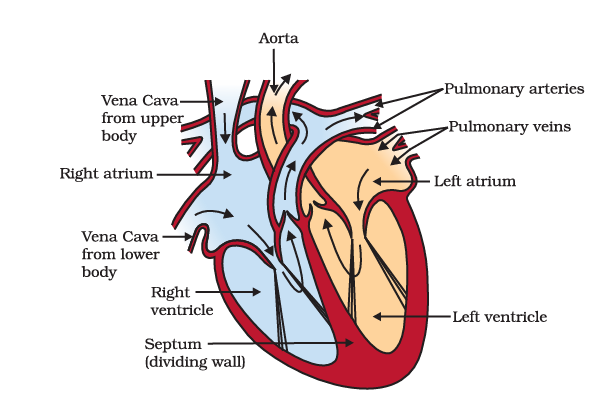
The heart is a muscular organ located in the thoracic region, slightly towards the left side of the chest. It serves as the primary pumping organ of the body. The human heart is divided into four chambers that play a crucial role in the circulation of oxygenated and deoxygenated blood. The upper two chambers are known as atria, while the lower two chambers are referred to as ventricles.
Blood Vessels
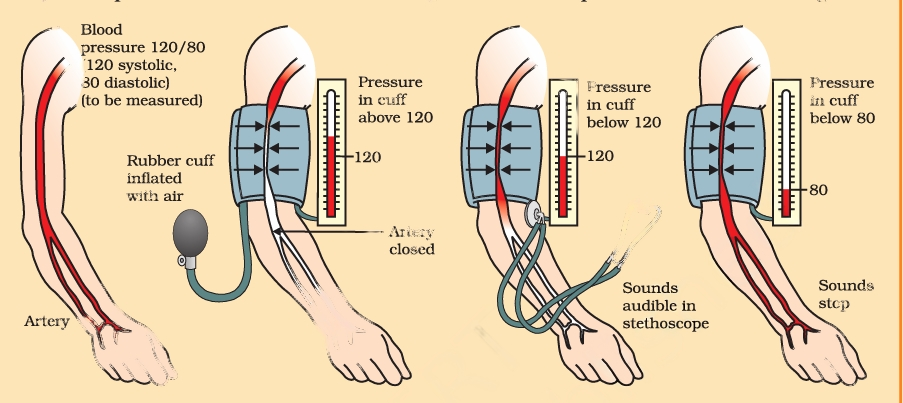
Blood vessels are responsible for carrying blood throughout the body. There are three main types of blood vessels: arteries, veins, and blood capillaries. Arteries are vessels that carry oxygenated blood, while veins carry deoxygenated blood. The exchange of gases between the blood and body cells takes place at the capillaries.
Blood Pressure
Blood pressure refers to the force exerted by blood as it flows through the blood vessels.
There are two types of blood pressure: systolic and diastolic. Diastolic pressure is the pressure on the arterial walls when the heart is in its relaxation phase, representing the minimum pressure in the arteries. The normal range for diastolic blood pressure is 60 – 80 mm Hg.
On the other hand, systolic pressure is the pressure on the arterial walls when the heart is contracting and pumping blood, representing the maximum pressure in the arteries. The normal range for systolic blood pressure is 90 – 120 mm Hg.
Bleeding
Bleeding occurs when blood vessels rupture, but it is a natural response to injury. The body’s defense mechanism involves platelets, which aid in blood clotting at the site of injury. Blood clotting is a process that forms a gel-like mass to prevent excessive blood loss from the body. This clot is created by the combination of platelets and fiber-like proteins found in the blood.
Double Circulation
In the human body, blood undergoes two rounds of circulation through the heart. The first circulation is during pulmonary circulation, where blood flows between the heart and the lungs. The second circulation is during systemic circulation, where blood is pumped from the heart to the rest of the body and back. This dual circulation in human beings is referred to as double circulation.
Life Process Notes Class 10 – Transportation in Plants
Transportation in Plants
Transportation is a crucial process in plants, ensuring the distribution of water and essential nutrients to all parts of the plant for its survival. Plants have separate transportation systems for food and water. Xylem is responsible for transporting water, while phloem transports food to various parts of the plant.
Phloem
The phloem plays a vital role in transporting nutrients and sugars, such as carbohydrates, from the leaves to metabolically active areas of the plant. This tissue consists of sieve tubes, companion cells, phloem fibres, and phloem parenchyma cells. The flow of materials through the phloem is bidirectional, allowing efficient distribution and utilization of nutrients throughout the plant.
Translocation
Translocation is the process of food transport in plants through the phloem, facilitated by mass flow. It involves the movement of photosynthates, which are sugars and organic molecules like amino acids, organic acids, proteins, and inorganic solutes such as potassium, magnesium, nitrate, calcium, sulfur, and iron.
These substances are transported from source tissues, like mature leaves, to sink cells, which are areas of growth and storage.
During translocation, sucrose is loaded from leaves into the phloem using the energy of ATP. This transfer leads to an increase in osmotic pressure, causing water to move from nearby cells into the phloem tissue, aiding the transport of materials through the phloem.
This osmotically generated pressure difference also enables the transfer of substances from the phloem to tissues where they are needed. In this way, the bulk flow of materials through the phloem occurs, driven by the osmotic pressure difference.
Xylem
Xylem tissue plays a crucial role in transporting water from the roots to all other parts of the plant. It is composed of various cell types, including tracheids, vessels, xylem fibers, and xylem parenchyma.
The flow of water and minerals through the xylem is always unidirectional, moving from the roots upwards to the rest of the plant. This one-way flow ensures efficient distribution of water and nutrients throughout the plant, supporting its growth and survival.
Root Pressure
- The movement of water through the xylem, from the roots to the upper parts of plants, is the result of various forces working in concert.
- One of these crucial forces is known as root pressure, which arises from the osmotic pressure within the cells of the root system.
- This osmotic pressure propels the sap to ascend through the plant stem and reach the leaves.
- Root pressure plays a vital role in the initial transportation of water up the root.
Transport of Water
Water is absorbed by the roots and then transported through the xylem to reach the upper parts of the plant. This upward movement of water, even in the tallest plants, is made possible by the combined action of several forces.
Firstly, imbibition occurs, where water is absorbed by solids, as seen in seeds taking up water when soaked.
Secondly, osmosis plays a vital role. Water moves from areas of lower concentration to areas of higher concentration, and at the roots, cells actively take up ions, resulting in varying ion concentrations. This leads to the movement of water within the root cells through osmosis, forming a continuous water column that gets pushed upwards. This phenomenon is known as root pressure.
Thirdly, transpiration also contributes to the upward movement of water. It creates a straw-like effect, pulling the water column upwards as water is continuously lost from the leaves.
All these forces, imbibition, osmosis, root pressure, and transpiration, work together to ensure the efficient transport of water through the xylem to all parts of the plant.
Life Process Notes Class 10 – Excretion in Humans
Excretion
Excretion refers to the elimination of metabolic waste materials and other non-useful substances from an organism’s body.
While animals possess an advanced and specialized excretory system, plants, on the other hand, lack a well-developed excretory system similar to that of animals.
Plants do not have specific organs dedicated solely to excretion, resulting in a relatively simpler excretion process compared to animals.
Excretion in Unicellular Organisms
Unicellular organisms, such as amoeba and bacteria, eliminate waste products by a straightforward process of diffusion through their general body surface.
In specific unicellular organisms like amoeba and paramecium, the surplus waste is excreted through small structures called contractile vacuoles.
Moreover, undigested food in these unicellular animals is expelled when the food vacuole combines with the general body surface and opens to the external environment.
Excretory System of Humans
The human excretory system comprises the following components:
– Two kidneys
– Two ureters
– A urinary bladder
– A urethra
This system is responsible for producing urine as a waste product.
Kidneys
The main excretory organs in the body are the paired kidneys, acting as the essential filtration units. Each kidney consists of numerous tiny filtration units known as nephrons.
These kidneys play vital roles, including:
– Filtering waste materials, medications, and toxic substances from the blood.
– Regulating the fluid balance (osmolarity) of the body.
– Managing ion concentration within the body.
– Regulating pH levels.
– Controlling the volume of extracellular fluid.
– Secreting hormones that aid in red blood cell production, support bone health, and regulate blood pressure.
Nephron
The nephrons serve as the fundamental structural and functional units of the kidneys.
In each kidney, there are millions of nephrons, which collectively form the essential building blocks of kidney function. Each nephron consists of two main parts: the Malpighian body and the renal tubule.
The Malpighian body comprises a cup-like structure called Bowman’s capsule, which surrounds a cluster of capillaries known as the glomerulus. Together, they function as a filtration system, separating waste materials from many useful substances.
The renal tubule consists of three regions: the proximal convoluted tubule, the Loop of Henle, and the distal convoluted tubule. These regions are responsible for reabsorbing valuable substances back into the blood and filtering out the remaining waste substances.
The final product produced by the nephrons is called urine, which includes the waste materials removed from the body.
Haemodialysis
When the kidneys stop working properly, it causes many problems. To help with this situation, a special method called dialysis has been created. Dialysis involves the use of a machine filter called a dialyzer or artificial kidney.
Its purpose is to eliminate excess water and salt, balance other electrolytes in the body, and remove waste products resulting from metabolism. During dialysis, blood is withdrawn from the body and passes through a series of tubes containing a semipermeable membrane.
On the other side of the membrane, a fluid called dialysate flows, which draws impurities through the membrane, helping to cleanse the blood of toxins and restore balance to the body’s internal environment.
Excretion in Plants
Cellular respiration, photosynthesis, and various metabolic reactions in plants result in the production of numerous excretory products. The major excretory products in plants include carbon dioxide, excess water produced during respiration, and nitrogenous compounds from protein metabolism.
Plants release two gaseous waste products: oxygen during photosynthesis and carbon dioxide during respiration. The elimination of gaseous waste occurs through stomatal pores on the leaves.
A fascinating aspect is that the oxygen released during photosynthesis is used for respiration, while the carbon dioxide released during respiration is utilized for photosynthesis. This demonstrates the interconnected and mutually beneficial nature of these essential processes.
Plants excrete excess water through transpiration. Moreover, they store organic by-products in various forms within different plant parts. For instance, gums, oils, latex, and resins are waste products stored in components like bark, stems, and leaves. Eventually, plants shed these parts as they grow and renew themselves.
A few examples of plant excretory products include oil derived from oranges, eucalyptus, and jasmine, latex from rubber trees and papaya trees, as well as gums from acacia trees. Additionally, at times, plants even excrete waste products directly into the soil.
Frequently Asked Questions on Life Process Notes Class 10
Q: What are life processes?
According to Life Process Notes Class 10, Life processes are the essential activities that living organisms perform to maintain their life and survive. These processes include nutrition, respiration, transport, excretion, regulation, reproduction, and growth.
Q: What is nutrition in life processes?
Nutrition is the process by which living organisms obtain and utilize nutrients from their environment. It involves ingestion, digestion, absorption, assimilation, and egestion of food to provide energy and essential substances for growth and repair.
Q: How does respiration occur in living organisms?
Respiration is the process of breaking down food molecules to release energy. In most living organisms, respiration involves the intake of oxygen and the release of carbon dioxide during the breakdown of glucose or other organic compounds.
Q: What is the significance of transport in life processes?
Transport refers to the movement of substances like nutrients, water, gases, and waste products within living organisms. It is essential for distributing nutrients and oxygen throughout the body and removing waste materials for excretion.
Q: What is excretion, and why is it necessary for living organisms?
Excretion is the process of eliminating metabolic waste products from the body. It is vital to maintain a balance of internal conditions, remove harmful substances, and prevent the accumulation of toxic waste that could be detrimental to the organism’s health.
Q: How do living organisms regulate their internal environment?
Living organisms maintain their internal environment through various mechanisms, such as feedback loops, hormonal regulation, and the nervous system. These processes help in adjusting and stabilizing internal conditions like body temperature, blood pH, and water balance.
Q: What is the role of reproduction in life processes?
Reproduction is the process by which living organisms produce offspring, ensuring the continuation of their species. It is essential for the survival and genetic diversity of the species.
Q: How do living organisms grow?
Growth in living organisms is the result of an increase in the number and size of cells. It occurs through cell division and the accumulation of new materials to develop and increase the overall size of the organism.
Q: Can you give some examples of life processes in plants and animals?
Sure! In plants, examples of life processes include photosynthesis (nutrition), transpiration (excretion), and growth. In animals, examples include breathing (respiration), digestion (nutrition), and reproduction.
Q: How do unicellular organisms carry out life processes?
As single-celled organisms, unicellular organisms carry out all life processes within a single cell.. They take in nutrients, carry out respiration, excrete waste, and reproduce all in a single cell.
Q: Why are life processes essential for the survival of living organisms?
Life processes are essential for living organisms because they enable them to obtain energy, nutrients, and oxygen required for survival, growth, and reproduction. These processes also help in maintaining the internal balance and removing waste products to ensure the proper functioning of the organism.
Read Also:
- Chemical Reactions and Equations
- Acids, Bases and Salts
- Control and Coordination
- How Do Organisms Reproduce?
- Heredity and Evolution
- Magnetic Effects of Electric Current
- Our Environment
- Metals and Non Metals Class 10 NCERT Science Chapter 3 Notes
- Human Eye and the Colourful World Notes Chapter 10 Science
- Complete Class 10 Study Material
- Class 10th Chapter 11 Science Notes for NCERT Students